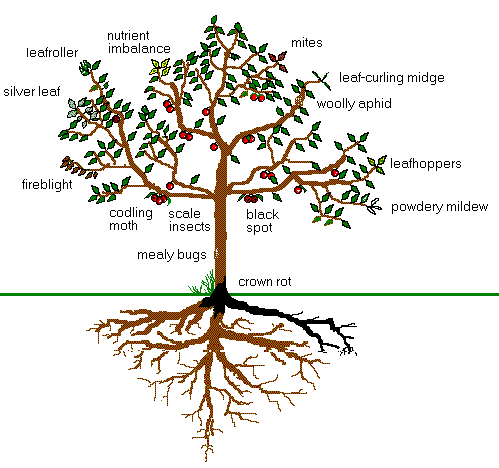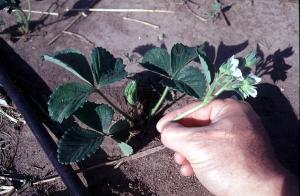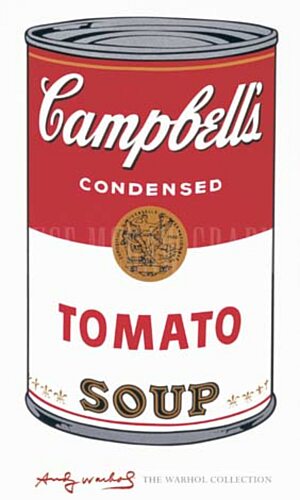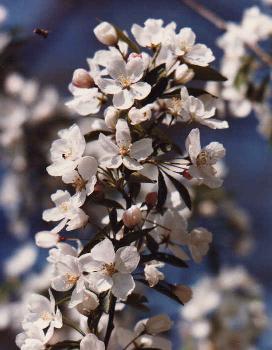Plants have their share of hormonal concerns and I like to compare my past agricultural experiences to the world of human hormones as they are quite relative. With my wife’s bout with pre-cancer a few years ago and the hormonal connection, it was natural for us to launch into a review of our past knowledge and take on new learning with it. As we have pointed out in our other writings it is not uncommon to find a more extensive knowledge regarding an issue such as hormones in the plant and animal area, versus trying to obtain insight from the human studies and human studies for some mysterious reason lag behind the plant and farm animal research. The almighty buck incentive could play a role for this, as the majority of humans place a great deal more importance on the buck than their health and I can say at one time we were part of the majority.
 We
had a period with fruit trees in the previous year, they called it fruit
differentiation. Depending on many factors determined how many fruit buds would
be developed during this previous year and in the process how much fruit would
be on the trees the next year. Mother nature in its desire to perpetuate a
species either human or plant would determine an environment for reproduction
(quality of the seed, amount of fruit buds etc, by the health of the tree at the
time. If a tree or even a human showed signs of demise, the plant would stir up
a dramatic surge toward reproduction. A human sample of this was during the
tuberculosis epidemics of the past when they found woman were more apt to become
pregnant if they had the disease. I have seen apple trees that were girdled from
mice damage to the point of dying that would produce an over abundance of fruit
buds. Conversely as many of our fellow gardeners have discovered being too good
to our tomato plants, (over fertilization) and making them lush and green worked
against our desire for a bountiful crop of tomatoes, as I am sure a bowl full of
tomato leaves would not be very appetizing. Very simply with the tomato plant
being very healthy, Mother nature just simply said, “Hey you don’t need to
reproduce, you are too healthy, let your master in the garden wielding the
fertilizer bucket go to the supermarket and pay a buck a pound or more for
his/her
We
had a period with fruit trees in the previous year, they called it fruit
differentiation. Depending on many factors determined how many fruit buds would
be developed during this previous year and in the process how much fruit would
be on the trees the next year. Mother nature in its desire to perpetuate a
species either human or plant would determine an environment for reproduction
(quality of the seed, amount of fruit buds etc, by the health of the tree at the
time. If a tree or even a human showed signs of demise, the plant would stir up
a dramatic surge toward reproduction. A human sample of this was during the
tuberculosis epidemics of the past when they found woman were more apt to become
pregnant if they had the disease. I have seen apple trees that were girdled from
mice damage to the point of dying that would produce an over abundance of fruit
buds. Conversely as many of our fellow gardeners have discovered being too good
to our tomato plants, (over fertilization) and making them lush and green worked
against our desire for a bountiful crop of tomatoes, as I am sure a bowl full of
tomato leaves would not be very appetizing. Very simply with the tomato plant
being very healthy, Mother nature just simply said, “Hey you don’t need to
reproduce, you are too healthy, let your master in the garden wielding the
fertilizer bucket go to the supermarket and pay a buck a pound or more for
his/hertomatoes".
 For
years with 30 acres of strawberries our biggest challenge was not having our
plants too lush, as berries suffered the same fate as an over lush tomato plant.
We solved this problem with a plant nutritional program that kept the plants a
little lean, and followed with airplane foliage feeding after the fruit was set.
For
years with 30 acres of strawberries our biggest challenge was not having our
plants too lush, as berries suffered the same fate as an over lush tomato plant.
We solved this problem with a plant nutritional program that kept the plants a
little lean, and followed with airplane foliage feeding after the fruit was set.In any event below is a short description of plant hormones that you should find interesting and perhaps you can become a more satisfied green thumber from it and if you can apply the knowledge to the human body, please share the information with the Blueeyedcurse.com folks. Better still send it to orders@epeacedale.com. Thanks
 This
article was taken out of the Albany Times Union on 8-10-03. It was written by a
Nancy O’Donnell. We did not receive permission to put this material on our
website because we have felt that public service messages such as this would be
whole heartily approved by the author, especially if the information could save
breasts and lives.
This
article was taken out of the Albany Times Union on 8-10-03. It was written by a
Nancy O’Donnell. We did not receive permission to put this material on our
website because we have felt that public service messages such as this would be
whole heartily approved by the author, especially if the information could save
breasts and lives.But what do hormones actually do?
The name comes from the Greek word “To excite”. The main purpose is to act as a chemical messenger, signaling to the plant that certain developments action must be undertaken. There are five classes of the hormones.
ABSCISIC acid can be found in stems leaves and unripened fruit. This hormone sends messages to the guard cells that protect stomates, alerting them that it is time to open or close. Stomates are those holes in the underside of the leaves. They open to absorb carbon dioxide from the atmosphere for photosynthesis. As you probably remember from science class, the by product of photosynthesis is oxygen. And since we love to breathe abscisic acid is a mighty necessary plant hormone.
 AUXIN
is found in young foliage; new buds located at stem tips and seed embryos. These
locations make sense when you figure it’s responsible for what’s called apical
dominance, or the outward growth habit of branch tips. When we pinch a plant, we
remove the AUXIN from the tip and allow the hormone found in smaller side-branch
tips to become dominant. (Blueeyed note: Reminds me of the studies involving
Estrogen dominance as it relates to breast cancer)
AUXIN
is found in young foliage; new buds located at stem tips and seed embryos. These
locations make sense when you figure it’s responsible for what’s called apical
dominance, or the outward growth habit of branch tips. When we pinch a plant, we
remove the AUXIN from the tip and allow the hormone found in smaller side-branch
tips to become dominant. (Blueeyed note: Reminds me of the studies involving
Estrogen dominance as it relates to breast cancer)But that is not AUXINS only functions: If you’ve ever noticed a plant bending forward toward a light source (phototropism) or wonder why roots grown down into the soil in response to gravitational pull (geotropism), thank AUXIN. This mighty hormone also assists in flower and fruit development of tiny roots and we try to root a cutting. (the active ingredients in rooting hormone powder Rootones is AUXIN.
CYTOKININ is manufactured in the plants root system. And then translocated. This hormone is the only one found in both plants and animals. Although AUXIN plays a role in cell division without CYTOKININS growth will be inhibited.
 ETHYLENE
is the only hormone found in a gaseous state and , yes, it’s also known as
ethylene gas, which we are often warned about when storing fruits and vegetables
(Blueeyed note: Ethylene has been used in ripening operations for years. Banana
and Tomato rooms in particular. Ripening fruits etc. artificially isn’t the same
as the full nature process, but in some cases do not impact the taste and
quality too much. Ripening a banana or a tomato on the turn is better than when
it is less mature. We knew of a farmer in south jersey with 300 acres of
tomatoes that picked this huge acreage source by hand for entry on the early
very expensive market, but then used ETHYLENE gas with an airplane to ripen the
balance in 20 acre increments for the Campbell soup company. (Nice little
profitable operation) ETHYLENE can be used in the kitchen very effectively if
used properly. The warning above would be for a process where lets say a ripe
apple was put in a paper bag with Tomatoes on the turn. Yes the ripe apple
emitting ETHYLENE gas will ripen the tomatoes for sure, but there are other
gases that will negatively impact the fruit, if you do not open up the bag a
little. Don’t forget them, because this ripening process can work fast.
ETHYLENE
is the only hormone found in a gaseous state and , yes, it’s also known as
ethylene gas, which we are often warned about when storing fruits and vegetables
(Blueeyed note: Ethylene has been used in ripening operations for years. Banana
and Tomato rooms in particular. Ripening fruits etc. artificially isn’t the same
as the full nature process, but in some cases do not impact the taste and
quality too much. Ripening a banana or a tomato on the turn is better than when
it is less mature. We knew of a farmer in south jersey with 300 acres of
tomatoes that picked this huge acreage source by hand for entry on the early
very expensive market, but then used ETHYLENE gas with an airplane to ripen the
balance in 20 acre increments for the Campbell soup company. (Nice little
profitable operation) ETHYLENE can be used in the kitchen very effectively if
used properly. The warning above would be for a process where lets say a ripe
apple was put in a paper bag with Tomatoes on the turn. Yes the ripe apple
emitting ETHYLENE gas will ripen the tomatoes for sure, but there are other
gases that will negatively impact the fruit, if you do not open up the bag a
little. Don’t forget them, because this ripening process can work fast.ETHYLENE also enables a plant to go through the aging process, which includes fruit ripening, autumn leaf drop and the ultimate death of the plant. Its location is indicative of its responsibilities; it can be found in ripe fruit, at the nodes where the leaves are attach the stems and in heavy concern rations in cells as the end of a plants life cycle near.
GIBBERELLIN is the fifth and final hormone. It’s found in the newly formed buds, roots and seed embryos. Responsibilities include stimulation of cell division and elongation, and the curtailment of seed and bud dormancy. An increase concentrations of GIBBERELLIN can promote biennial flowers to bloom their first years rather than waiting for the normal second year bloom. More than 40 different forms of GIBBERELLIN have been identified.
 Blueeyed
Note: Referring to biennial flowering. We had a problem with fruit trees that
had a habit of a great crop one year and little the next. The great year
produced small apples and it was our preference to have consecutive years of big
apples. We had a professor from Cornell, Pete Hoffman a southerner who came down
one August during the fruit differentiation period of a rather stubborn biennial
bearer (Northern Spies) with a linoleum knife and actually temporarily girdled
some experimental trees, actually ran the knife completely around and severed
the cambium layer. The object was to constrict the ability for fruiting hormones
from traveling up into the network of the tree and settling in the area
necessary to develop fruit buds. This stopped the over supply of hormones that
created a heavier set. We combined this practice with chemical thinning that
worked well most of the time.
Blueeyed
Note: Referring to biennial flowering. We had a problem with fruit trees that
had a habit of a great crop one year and little the next. The great year
produced small apples and it was our preference to have consecutive years of big
apples. We had a professor from Cornell, Pete Hoffman a southerner who came down
one August during the fruit differentiation period of a rather stubborn biennial
bearer (Northern Spies) with a linoleum knife and actually temporarily girdled
some experimental trees, actually ran the knife completely around and severed
the cambium layer. The object was to constrict the ability for fruiting hormones
from traveling up into the network of the tree and settling in the area
necessary to develop fruit buds. This stopped the over supply of hormones that
created a heavier set. We combined this practice with chemical thinning that
worked well most of the time.